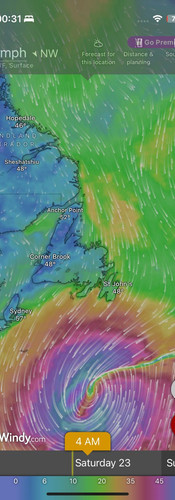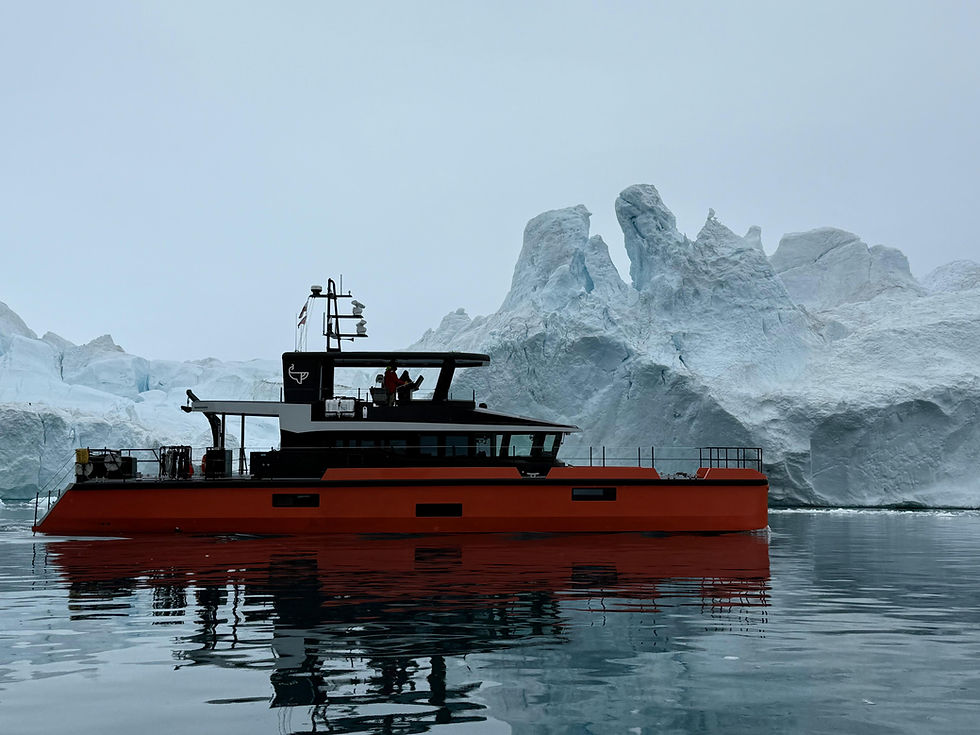South Across the Labrador Sea - Running Before the Wind.
- Chris Leigh-Jones
- Aug 26
- 4 min read
Updated: 23 minutes ago
As the first snow of winter kissed the mountains behind Nuuk, Greenland, we set forth into the Labrador Sea. With a trove of memories to sort, our journey of 2500 nautical miles home down the Atlantic coastline began. By the time we reach Halifax, NS, we will be halfway home.

Crossing the Labrador Sea
Our voyage plan was to take the shortest route across, approximately 650 nautical miles to Cartwright. We intended to hunker down while Hurricane Erin passed off the southern coast of Newfoundland. Although Erin weakened to a Category 2 storm, her effects were significant as she moved east along the Eastern US Seaboard. A low-pressure system formed around Cape Farewell at the southern tip of Greenland. Instead of spinning off east, it headed due west (thanks, Erin). We chose to ride the northern edge of this depression, ensuring both winds and waves were at our stern for the crossing.
The journey was a little lumpy but dry and quite quick. Even with stabilizers deployed, we averaged over 8 knots at 1600 engine RPM. Four days and a hard-won 780 nautical miles later, we entered the Gulf of St. Lawrence at Belle Isle.

480 nautical miles into the crossing, the winds veered south, causing most of the swell to follow suit. We encountered 4-meter wave heights with a long period as they approached from the stern. We rocked and rolled, but our decks stayed dry, and we even surfed a little (turn up the autopilot gain to max or risk bow steering). Cartwright was soon jettisoned in favor of Belle Isle and the entrance to the St. Lawrence Seaway.
The currents here are complex, cycling between slack water and about 3.0 knots easterly. They do not mirror the tide. Our plan was to take advantage of the current and whatever wind remained, motoring down to the nearest bunker port, Port Au Choix. We aimed to top up our fuel tanks on Monday and then press on the next day, checking in at Sydney, cruising the lakes of Nova Scotia, and onward to Halifax.
In the Eye of the Beholder
I had a chance to converse with our youngest son, Rhys, who is along for the journey. Port au Choix is a typical Newfoundland location. It has its obvious challenges for the locals, and it's easy to be critical, given a privileged past. However, the community has been overtly welcoming, with a plethora of friendly locals.
They make the most of what they have in a rough world. Openness, generosity, and curiosity are evident everywhere. There is pride in their past and a hard-working fishing fleet. The free, clean facilities and the sharing of stories are heartwarming. I do enjoy stories. This land, like many, is what you make of it.
How Did Vanguard React in Steep Ocean Seas?
Our ice pilots are part of a very small community that takes suitable yachts into high latitudes. They recently provided direct feedback on how Vanguard behaved in a seaway, comparing this to their experiences with contemporaneous FPBs of similar size.

Most of the time, we sail without deploying stabilizers. This approach is faster and consumes less power. It provides a comfortable motion up to Force 3/4 and/or about a 1.5-meter swell on the bow/stern or 1 meter on the beam.
Currently, we are sailing in Force 4/5 wind with a 4-meter swell on the stern quarter. Stabilizers are deployed, and she is bouncing along, rolling 5 to 10 degrees and pitching. However, there is no slamming or bow steering, provided the autopilot is set to a fast response. The motion is similar to that of an FPB 70, which has forward lift in waves, some way back from the bow. The swim platform gets wet in a following sea but is generally otherwise dry.
Without stabilizers and in a beam sea, the tendency to roll is much reduced, similar to that of an FPB 78. We also experience less wind heel, possibly due to the open flybridge design.
We received incisive and unique feedback from their direct experience.
Chris Leigh-Jones
Tuesday am - Just departing Port au Choix, a gift of moose and smoked mackerel from a friend ashore and a thank you note for the absent Harbor Master. I like this place.
Conclusion
Our journey across the Labrador Sea has been filled with challenges and memorable moments. The beauty of the landscape, the unpredictability of the weather, and the warmth of the communities we encounter make this adventure worthwhile. As we continue our voyage, we look forward to the experiences that lie ahead and the stories we will gather along the way.

























Comments